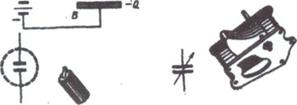UNIT III. POWER ENGINEERING
TEXT 1. Electric Circuit
This is a circuit. Its elements are a voltage source, a resistor and a conductor. The circuit consists of a voltage source, a resistor and a conductor. A voltage source supplies current. A resistor reduces current. A conductor connects the elements of the circuit
Compare circuit a with circuit b. What is the difference between them? Current passes through circuit a while no current passes through circuit b. Circuit b has an open. No current through circuit b results from an open. An open and a short are troubles in a circuit. A trouble in a circuit may result in no current in it.
TEXT 2. Series Circuit and Parallel Circuit
Compare circuits a and b. Circuit a consists of a voltage source and two resistors. The resistors are connected in series. Circuit a is a series circuit.
Circuit b consists of a voltage source and two resistors. The resistors are connected in parallel. Circuit b is a parallel circuit.
A parallel circuit has the main line and parallel branches.
In circuit b the value of voltage in R1 equals the value of voltage in R2. The value of voltage is the same in all the elements of a parallel circuit while the value of current is different. A parallel circuit is used in order to have the same value of voltage.
In circuit a the value of current in R1 equals the value of current in R2. The value of current is the same in all the elements of a series circuit while the value of voltage is different. A series circuit is used in order to have the same value of current. In R1, V1=IR1 is the voltage drop in R1. In circuit c a trouble in one element results in no current in the whole circuit. In circuit d a trouble in one branch results in no current in that branch only, a trouble in the main line results in no current in the whole circuit.
TEXT 3. Capacitors
A capacitor is one of the main elements of a circuit It is used to store electric energy. A capacitor stores electric energy provided mat a voltage source is applied to it.

Fig.8 Fig.9
The main parts of a capacitor are metal plates and insulators. The function of insulators is to isolate the metal plates and in this way to prevent a short
In the diagram one can see two common types of capacitors in use nowadays: a fixed capacitor and a variable one. The plates of a fixed capacitor cannot be moved; for this reason its capacity does not change. The plates of a variable capacitor move; its capacity changes. The greater the distance between the plates, the less is the capacity of a capacitor. Variable capacitors are commonly used by radiomen; their function is to vary the frequency in the circuit. Fixed capacitors are used in telephone and radio work.
Fixed capacitors have insulators produced of paper, ceramics and other materials; variable capacitors have air insulators. Paper capacitors are commonly used in radio and electronics; their advantage is their high capacity: it may be higher than 1,000 picofarad.
Besides, electrolyte capacitors are highly in use. They also have a very high capacity: it varies from 0.S to 2,000 microfarad. Their disadvantage is that they change their capacity when the temperature changes. They can operate without a change only at temperatures not lower than -40 degrees C.
Common troubles in capacitors are an open and a short. A capacitor stops operating and does not store energy in case it has a trouble. A capacitor with a trouble should be substituted by a new one.